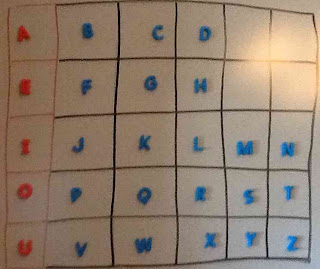I was floored at a workshop about a year ago when someone
asked me if it really ‘matters’ that students with multiple disabilities have
moved from being ‘precommunicative’ (i.e., making random marks and scribbling
without meaning) to being ‘semiphonetic’ spellers.
According to Gentry (Monster Test,1985):
SEMIPHONETIC SPELLERS know that letters represent
sounds. They perceive and represent reliable sounds with letters in a type of
telegraphic writing. Spellings are often abbreviated representing initial and /
or final sound. Examples: E = eagle; a = eighty.
My initial reaction was to say,
‘Of COURSE it matters!!’ Then I
forced myself to let reason rule over passion, and to really think about
it. The question was asked in reference
to a high school student, who had previously had no use of the alphabet. Instruction was started at the end of
high school, and he made great progress, being able to master most initial
sounds in words. But . . . did
that truly make a difference in the quality of life for that student? And would it matter for others??
I’ve been collecting ‘evidence’
for the past year, and the answer is a resounding YES, especially for students
who use augmentative communication.
Here are a few examples of how learning
to correctly represent initial sounds have supported some students I know (all
names fictional to preserve privacy):
Elena, age 9, was able to:
• Name her doll, but first
selecting the letter Q from an alphabet flip chart, then looking at multiple
post-its with possible names (Queenie was the result!)
• Initiate conversation about a
new hair color of a therapist by going to her alphabet flip chart, spelling R,
glaring at the therapist until the partners guessed, then going to the device
and saying LIKE, LIKE, LIKE
• And other examples way too
numerous to mention
Jonathan, age 16, was able to use
his device to give a general request, then use the alphabet page to be
specific. Samples include:
• DRINK . . . M D (Mountain Dew)
• FRIEND . . . L (Larry)
• MOVIE . . . SK (Shreck)
Many students in Mrs. Susan’s
class are ‘Voting by Letter’ (see Tip of the Month at www.aacinterventioncom / February,
2010). In this way they use first
letters to vote for:
• Books (about volcanoes or
hurricanes)
• Friend to sit with them at lunch
• What game to play
• What to do during recess (Walk /
Gym)
A number of students have
successfully learned Initial Letter Cueing in which the student who tends to
omit or distort initial consonants uses a cueing chart to supplement oral
speech by:
• Indicating the initial sound
• Tapping to show the number of
syllables in the word.
:
This has been so successful that
after one frustrating experience at a fast food place, one 7-year-old told his
Mom, “I’m never leaving home without my letter board.”
So, “Yes, Virginia, there IS a place
for semiphonetic spelling!”
P.S. In my experience, most
students who develop semiphonetic spelling go on to become phonetic spellers
and beyond!!









